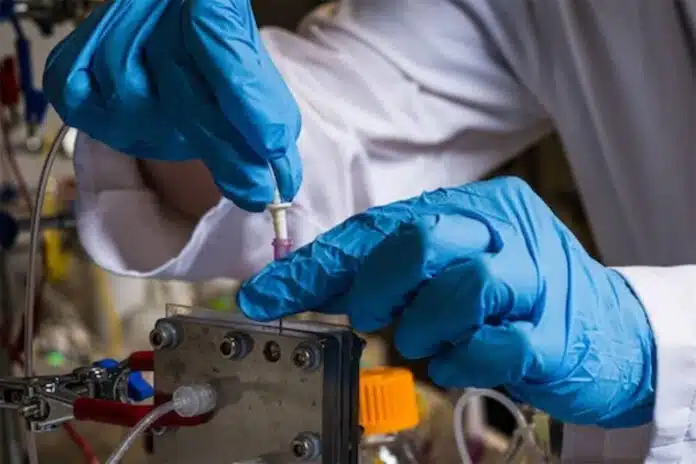
By Ashwini Sakharkar 17 Aug, 2024
Collected at: https://www.techexplorist.com/new-reactor-system-produces-green-ammonia-purified-water/87349/
Ammonia is a crucial component in supporting the global food production necessary for the growing population, but its production contributes to approximately 2% of the world’s energy consumption and 1.4% of carbon dioxide emissions.
Engineers at Rice University have created an innovative reactor design that could revolutionize ammonia production. This new system not only decarbonizes the production process but also helps to reduce water pollution by converting nitrates, common pollutants, into valuable ammonia. This breakthrough has the potential to make a positive impact on various industries, from agriculture to manufacturing.
Ammonia stands as one of the most extensively manufactured chemicals globally, with a demand exceeding 180 million tons annually. The primary method of production is the Haber-Bosch process, necessitating high temperature and pressure conditions for the reaction between hydrogen and nitrogen, relying on large-scale centralized infrastructure. An alternative approach is electrochemical synthesis, leveraging electricity to facilitate chemical reactions.
“Electrochemistry can occur at room temperature, is more amenable to scalable formats for different infrastructure systems, and has the capacity to be powered by decentralized renewable energy,” said Feng-Yang Chen, a Rice graduate student who is the lead author of the study. “However, the current challenge for this technology is that large quantities of additive chemicals are required during the electrochemical conversion process. The reactor we developed uses recyclable ions and a three-chamber system to improve the reaction’s efficiency.”
The utilization of a porous solid electrolyte marks a significant advancement as it eradicates the necessity for high concentrations of supporting electrolytes, a persistent issue in prior sustainable attempts to convert nitrates to ammonia. Additionally, by harnessing renewable energy to power the conversion process, ammonia production can achieve carbon neutrality.
“We conducted experiments where we flowed nitrate-contaminated water through this reactor and measured the amount of ammonia produced and the purity of the treated water,” said Chen, who is pursuing a doctoral degree in chemical and biomolecular engineering under Wang’s supervision. “We discovered that our novel reactor system could turn nitrate-contaminated water into pure ammonia and clean water very efficiently, without the need for extra chemicals. In simple terms, you put wastewater in, and you get pure ammonia and purified water out.”
The newly developed reactor system facilitates an electrochemical nitrate-to-ammonia conversion route, eliminating the requirement for denitrification. This process bypasses the traditional denitrification and Haber-Bosch routes, offering an efficient water decontamination method in addition to sustainable ammonia production.
“Nitrate is one of the priority pollutants that most frequently violate drinking water standards, and it is a is a significant concern in growing cities as farmland with nitrate-contaminated groundwater supplies is converted to urban development,” said Pedro Alvarez, the George R. Brown Professor of Civil and Environmental Engineering, director of the Nanosystems Engineering Research Center for Nanotechnology-Enabled Water Treatment (NEWT) and the Water Technologies Entrepreneurship and Research (WaTER) Institute at Rice.
According to Alvarez, “conventional nitrate removal in drinking water treatment involves ion exchange or membrane filtration by reverse osmosis, which generates brines and transfers the nitrate problem from one phase to another.”
“Professor Wang’s innovation is very timely and important, as it offers a solution that eliminates nitrate toxicity and associated liability without the need to add treatment chemicals,” Alvarez said.
The impact of this research stretches far beyond ammonia production. The innovative reactor design and the comprehensive techno-economic evaluation provide valuable insights for advancing eco-friendly chemical processes. This could potentially revolutionize how industries tackle environmental issues.
“Our findings suggest a new, greener method of addressing both water pollution and ammonia production, which could influence how industries and communities handle these challenges,” said Wang, associate professor of chemical and biomolecular engineering, materials science and nanoengineering, and chemistry at Rice. “If we want to decarbonize the grid and reach net-zero goals by 2050, there is an urgent need to develop alternative ways to produce ammonia sustainably.”
Journal reference:
- Feng-Yang Chen, Ahmad Elgazzar, Stephanie Pecaut, Chang Qiu, Yuge Feng, Sushanth Ashokkumar, Zhou Yu, Chase Sellers, Shaoyun Hao, Peng Zhu & Haotian Wang. Electrochemical nitrate reduction to ammonia with cation shuttling in a solid electrolyte reactor. Nature Catalysis, 2024; DOI: 10.1038/s41929-024-01200-w

Leave a Reply